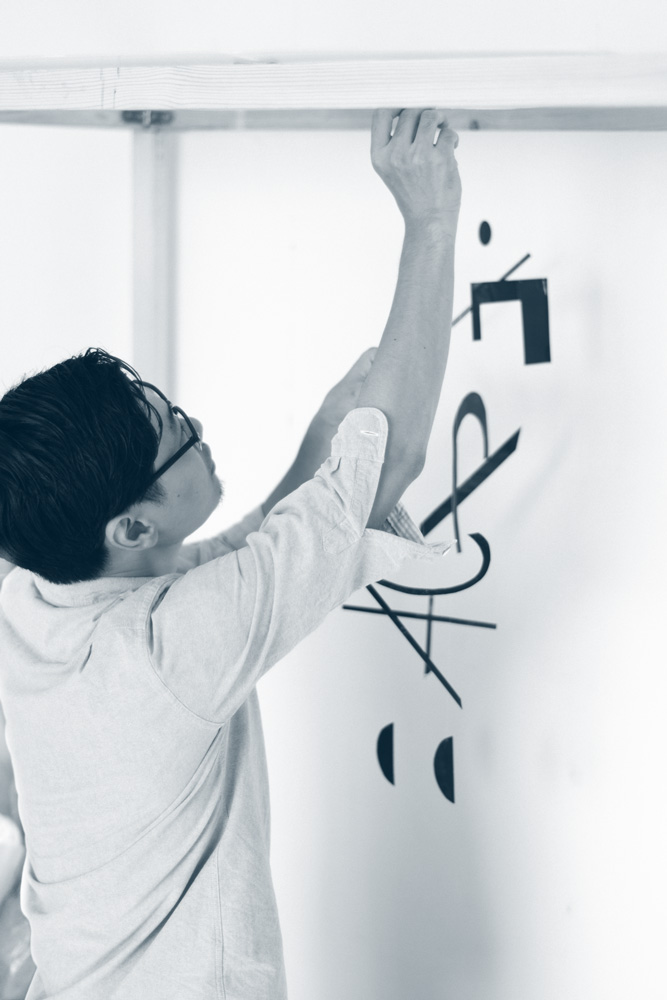
Daijiro OHARA
A designer based in Tokyo, focuses on typography, graphics, sculptures and editorial projects.
–
mail ohara@omomma.in
instagram @daijiro_ohara
twitter @omomma_
–
大原大次郎
1978年神奈川県生まれ。2003年武蔵野美術大学基礎デザイン学科卒業。
タイポグラフィを基軸とし、グラフィックデザイン、ブックデザイン、イラストレーション、CI、映像制作などに従事するほか、展覧会やワークショップを通して言葉や文字の新たな知覚を探るプロジェクトを多数展開する。
近年のプロジェクトには、重力を主題としたモビー ルのタイポグラフィシリーズ〈もじゅうりょく〉、ホンマタカシによる山岳写真と登山図を再構築したグラフィック連作〈稜線〉、音楽家・蓮沼執太、イルリメと共に構成する音声記述パフォーマンス〈TypogRAPy〉、YOUR SONG IS GOODの吉澤成友と展開するライブプリントとドローイングによる即入稿セッション〈New co.〉などがある。
受賞に、JAGDA新人賞、東京TDC賞。
武蔵野美術大学、京都造形大学、東京藝術大学非常勤講師、美学校講師。
編著に『作字百景』(グラフィック社)、共著に『稜線』(between the books)、『ハロー風景』、『New co. – KAKUBARHYTHM Graphic Archives-』。
–
-
Daijiro OharaBorn in Kanagawa of Japan, 1978. Graduated from the department of Science of Design at Musashino Art University in Tokyo, and started working independently in 2003.Graphic designer and a guest professor at Tokyo University of the arts, Musashino Art University, and Kyoto University of art and design.Expanded projects seeking sensation and perception of words and letters, through graphic design, exhibitions, and workshops. His some main projects include a mobile of typography “Typogravity” topicalizing gravity and graphic series “Ridge Line” reconstructing mountain photography and trekking maps by Takashi Homma. “TypogRAPy” is sound project with Shuta Hasunuma and Jun Kamoda a.k.a Illreme.Awarded JAGDA New Designer Award and TOKYO TDC Award.
–
方法の行方
室賀清徳〈IDEA magazine〉
デザインの黄昏から
モダンデザインは直線的な技術と経済をルールとして駆動してきた。
テクノロジーの刷新はルールに本質的な問いを投げかけるのだが,現実はいつも市場の論理に回収されてきた。ポスト工業化時代においては,デザイナーは直線的な構造の中で,ますます抽象的な存在になっていく。
現代のグラフィックデザイナーはそこでいかに固有名を確保できるのか? 2000年代に欧米圏を中心に流行したグラフィックデザイナーによる自主出版や自主プロジェクトの潮流には,急激に進展したグローバル経済やテクノクラシーのなかで,デザイナーと社会とのつながりを生産行為を通じて再設定しようという態度が感じられた。
このような動向は同時期の日本にも少なからず影響を与えたが,zineブームなども含め,「ものづくり」的,クラフト的嗜好のなかで受け止められたように思われる。
日本では,いつのころからか西洋由来の「デザイン」という考え方について本質的に検討する視点が喪われてしまった。とくに近年は方法のジェネリック化とコモディティ化が進行し,デザインはひとつの規律訓練(ディシプリン),つまり「そういうもの」として議論の対象ではなくなった。
ここにひとつの逆説がある。「モダンデザイン」という定規を外部から持ち込んだ日本では「デザインとは何か」という問いかけが,批評的な思考と実践の推進力となってきた。つまり,誤解や曲解も含めたデザイナーたちの思考の総体とその曲がりくねった軌跡が,戦後日本のグラフィックデザインにある一定の強度をもたらしていたと言えるのだ。フラットな情報環境のなかでデザイナーたちは思考の運動性を失い,「デザインとは何か」という問いはいまや単なるセルフプロモーションの口上へと堕した。
「かく」ことの根源へ
大原大次郎の仕事が注目されたのは,そんなグラフィックデザインの熱死的状況が日常となった2000年代中頃であった。大原の名を一躍知らしめたのは,ポップな描き文字を駆使した音楽関連のデザインワークだった。戦後の商業レタリングの要素を汲み取りつつ,イラストレーションやテクスチャを現代的に総合させた大原の描き文字は,同時期に高まっていたタイポグラフィや文字,クラフト的な質感への関心にも合致して人気を集め,多くのフォロワーを生むことになった。
しかし大原にとってそのような描き文字はあくまでもプロジェクトごとの特殊な要請やプロセスの成果物であって,それ自体が問題なのではなかった。同時期以降のグラフィックワークにおいても大原は描き文字にこだわることなく,イラストレーションやオブジェ,写真などさまざまな素材を自在に駆使していく。
大原の実際の関心はどこにあったのか? その答えは,2010年代以降にクライアントワークと平行して積極的に展開された展示プロジェクトやワークショップを通じて次第に明らかになっていった。
これらの展示やワークショップの中心テーマとなっているのはいずれも「かく」「はなす」という身体行為を通じた主体と世界の関係性であった。大原がこの問題系について考え始めるきっかけとなったのは,書家・石川九楊が『筆触の構造』で提示していた,「かく」「はなす」という人間の身体と創造行為の関係性であった。
石川によれば「はなす」とは「人間が身体の各部のはたらきを総動員して,意識を中空に放出する表出行為」であり,発話,身振り,歌唱といったパフォーミングアーツがこれに属する。また,「かく」とは「人間が道具を手にして,自然などの対象に働きかけ,これを減算(マイナス)的に変形するという方法によって意識を表出する行為」であり,文字,絵画,彫刻,書などが属する。
「イラストレーション」「デザイン」「アート」のような制度的区分がもたらす抑圧にとらわれないこのような考え方を天啓とし,大原は「かく」「はなす」を通じた製作の深部へ下降していく。
方法と製作と
大原は「デザイン」という近代概念によって世界が分節化される以前の原初へと遡り,身体と行為を手がかりに「デザイン」という言葉で示されていた領域をあらためて読み直そうとしている。このような人類学的な視点の応用は,日本の近代デザイン思想のなかでは見落とされてきた部分ではないだろうか。「グラフィック」とはギリシャ語の「かく」ことを意味する「グラフィコス」に由来し,大原のように「かく」原理からグラフィックデザインを捉え直すことは言葉の正しい意味で「グラフィック」の問題系を捉えることにほかならない。
ところが日本では長年「グラフィック」という語が印刷を中心とした産業的,時代的エートスにおいてのみ理解されてきたため,いつまでもポスター的な図像としての理解から脱出できないでいる。欧米に追いつくことを急いで技術導入を優先してきた経緯からすれば,大原のような視点は,ポスト工業化時代に移行した現代だからこそ見えてきた部分かもしれない。
かつてのデザイナー的エートスとの対比でいえば,大原の展示やワークショップは,アーティストを擬制するような,「クライアントワーク」に対する「自己表現」として特権化されたものではないことも重要である。そこでは自主プロジェクトの成果がコマーシャルな仕事で展開されるのと同様に,コマーシャルな環境はそれ自体がひとつの実験場であり,次のプロジェクトの起点にもなっている。
このようなプロジェクトの相互参照のみならず,大原は音楽のような他の専門領域で培われた方法論やコンセプトの転用・流用にも積極的だ。「かく」ことの先に待っている純粋表現の領域を回避し,コミュニケーション領域にとどめているのは,この「方法」への立脚にほかならない。
たとえば,大原の方法のひとつには,まぎれもなく「タイポグラフィ」がある。一見,活字と関係のないドローイングやグラフィックがタイポグラフィとして組み立てられる。それは造形としてのタイポグラフィではなく,要素をある法則のもとに構成・配列するという記譜法,世界の認識と構築の方法論としてのタイポグラフィだ。このような意味で,大原を「方法の人」と呼ぶことは可能だろう。書字行為から導かれる聴覚的形象と視覚的音像を往復しながら楽曲をコンポーズしていくプロジェクト「TypogRAPy」では,ついには方法が総合芸術にまで高められようとしている。
実践×思考
デザインの現場で日常的に用いられる「ワークフロー」や「ディレクション」という言葉には,合理的で直線的なニュアンスがつきまとう。この当たり前の世界観に対して,大原の道筋はあまりにも迂遠で,曲がりくねっているように見える。大原大次郎の一連の試みがどの程度まで成功してきたのか,私はそれを査定できる立場にはない。だが,大原の一見してポップな活動の向こうにつねにひっかかるものを感じるのは,その紆余曲折に蓄積された荒削りな説得力が潜んでいるからだ。
折しも,オリンピック東京2020大会のエンブレム問題によってグラフィックデザインの制度的枠組みと同時代的な情報リアリティとの断層が露わになり「デザインとは何か」「デザインはどうあるべきか」といった本質的な問いが数十年の空白を超えて再起動されようとしている。
われわれの思考や行動様式には「デザイン」という言葉がすでに循環回路のようにインストールされており,「デザイン」を論ずるに「デザイン」以外の言葉を使う方法がないようだ。だが,そのような議論の先には構造的な不毛さが待っている。
そのとき,大原のように「デザイン」という言葉を使わずにデザインを語るような,あるいはタイポグラフィの方法を横領し転換することでタイポグラフィ的コミュニケーションの線状的な抑圧を打破するような,方法的転回が求められるだろう。
大原が先行して積み上げてきた,そしてこれからも継続されていく実践的思考と思考的実践に注目したい。
–
Searching for Methods
Text: Kiyonori Muroga 〈IDEA magazine〉
Current design
The modern design is developed within rules of linear technique and economy. The reform of technology challenged those rules, but the reality has been always ruled by the market fundamentalism. In the post-industrialization era, designers becomes more and more an abstract existence in the linear structure.
How can modern graphic designers be recognized under their own name. Independent publications and projects by graphic designers have become popular in the 2000s mainly in Europe and the US. Through those movement graphic designers seemed to have tried to relate themselves with society through their productions in the rapidly developing world economy and the technocracy.
Japanese graphic designers under such an influence those days, and including zine booms, regarded that trend as the fashion of craft, “manufacturing”. Japanese designers have gradually forgot to consider the heterogeneity of “design” of the Western origin after rapid economic growth. Particularly in latest years genericization and commoditization of design methods developed, and people haven’t discussed whether it was appropriate or not, after all they accepted design as it was, and it became a discipline.
Here is one paradox. For Japanese designers to ask themselves “what is design?” became a driving force of critical thinkings and practices while a measure, “modern design” have brought from the outside of Japan. In other words, it may be said that the whole ways of thinking of designers including misunderstandings and perversions brought constant strength in Japanese graphic designs after the world war II. Designers lost dynamics of thought in global informational environment, and the question “what is design?” lapsed into business catch phrases now.
Toward the origins of “hand writing”
It was the mid-2000s, the dying of those graphic designs became an everyday affairs when works of Ohara Daijiro gathered attention. It was design work for music industry with full use of pop hand writings to make him spring into fame. He integrated illustration and texture in modern style adding tastes of commercial lettering after the WWII. While interests for typography, letter, and tastes of craft increased, his styles became popular and produced many followers.
However, those lettering of hand writing is not the point for him, as those were just outcomes of each project’s request and process. He never clang to hand writing, made full of various materials, such as illustration, objects, and photograph as he liked after the period.
The answer what was he interested in gradually became clear through a display project and a workshop held vigorously parallel to client work in the after 2010s.
The main theme of these display and workshops was a relationship between a subject and the world through physical actions like “to write” or “to speak”.
Ohara began to think over it, after he knew that Ishikawa Kyuyo, a famous calligrapher, explained a relationship between human body and the act of creating, such as “to speak” “to write” in his book,”structure of a touch of a brush.
According to Ishikawa, “to speak” is “an expressing act of a human being through mobilizing all the functions of physical parts to release consciousness to the air” and utterance, gesture, and performing arts such as singing belong to it. On the other hand, “to write” is “an expressing act through working on objects such as nature with a tool and transforming them reducedly” and letter, drawings, sculptures, and books belong to it.
He was inspired the idea free from the suppression of the institutional division such as “illustration”, “design” or “art” and he began to explore the heart of production through “writing” and “speaking”.
Method and power
Ohara went back to the point where design originally occurred from the given environment divided by the modern concept of “design” and try to comprehend so called “design” field by reconsidering physical actions. Such an application of an anthropological viewpoint may have been overlooked in the Japanese modern design development. “Graphic” comes from a Latin word “gráficos”, so as Ohara has been doing, “to re-comprehend graphic design from the viewpoint of “how to write” is literally appropriate in comprehending set of issues of “graphic”.
However, in Japan for many years as “graphic” has been accepted only in an industrial aspect or the trend of the times, mainly printing, we never stop regarding graphic design as concrete object like “poster design”.
It may be the evil of prioritizing technology introduction to catch up with Europe and the US rapidly or we may have come to realize what the problem was simply because now is the time of the post-industrialization Era.
It is important to know that Ohara’s display and workshop are not privileged as are important to an ex-graphic designer not being a thing made a special privilege as “self-expression” as graphic designers once pretend to be an artist contrary to “the client work”.
As the outcome of the Ohara’s independent project develop in work in the commercial world, commercial environment is a test cite, and also become a start point for the next project.
As well as the cross reference of each project, Ohara also promotes conversion and diversion of methodology and the concept cultivated in other domains such as music. If we pursue “writing”, we are prone to be constrained by the field of pure expression, the way to avoid that and to remain using design as communication is to be conscious of application of methodology of the other field.
Ohara is not only the specialist of handling “letter” as mentioned above, however, his methodology mainly depend on “typography”. It is the typography as musical notation, composing and arranging sets of elements under a certain law, or methodology of recognizing and constructing the world, not the typography as formative art. In that sense Ohara can be called “the person of the method”. In “TypogRAPy, a project with Hasunuma Shuta and llreme, composing musical pieces by going between audible figures and a visible sound images led by a writing act, Ohara’s methodology is going to be raised in comprehensive art at last.
Practice and thought
The word “workflow” and “direction” implies senses of rationality and linearity. Ohara’s way seems to be too complex and wind for this conventional view of the world. How successful have Ohara Daijiro’s series of attempts been? I have no privileges to judge that, but I find something important through apparently pop practices because his complicated methodology has strong persuasive power.
Now that the dusputed issue of the emblem for the 2020 Tokyo Summer Olympics revealed the gap between an institutional frame of graphic design and real information of today, essential questions such as “what is design?”, or”What should design be?” are reappearing after missing decades.
The word “design” is installed in our way of thinking or behavior a circulation circuit and we do not seem to be able to discuss ”design” without using the word “design”, but if we discuss it in that way, after all the discussion is intrinsically barren.
There ought to be methodological turn as Ohara’s attempt to redivide graphic design from the perspective of anthropology or as his repel suppression of the linear communication of the typography by taking over and converting the methodology of typography.
I’d like to watch carefully Ohara’s practical thought and practices through thought process which he has already piled up and is probably continuing from now on.
–
 http://omomma.in/
http://omomma.in/